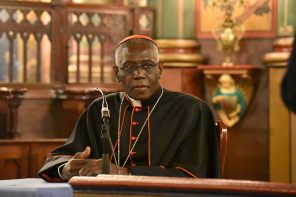Unless you are a global health policy wonk in Washington, the Minister of Health from South Africa, or the head of a clinic distributing anti-retroviral therapy in Botswana, you may not have been waiting with bated breath to hear who would fill the position of Global AIDS Coordinator in Obama’s administration.
For that matter, you may not have even heard of the position. It might have flown past your radar that on Monday April 27, the White House issued a press release announcing President Obama’s intent to nominate Dr. Eric Goosby to the position responsible for overseeing the President’s Emergency Plan for AIDS Relief, or PEPFAR. What’s PEPFAR? It is a bipartisan initiative to help prevent the spread of HIV and to offer care and treatment services to those living with or affected with HIV/AIDS globally. If you have missed all of this, it’s a good time to catch up.
PEPFAR is perhaps one of the United States’ most expansive humanitarian and diplomatic efforts, and it is now entering a critical stage. The outcome of this effort will be our legacy years from now, when the world assesses the response to one of the most devastating crises of our time, and measures the depth and breadth of our generosity, wisdom, and compassion.
Intended as an emergency intervention, PEPFAR initially committed $15 billion dollars over five years, with $19 billion appropriated in the end to the 15 countries hardest hit by the HIV/AIDS epidemic (and least equipped to respond on their own). The greatest impact of PEPFAR has been the widespread access to treatment. As a result, an HIV-positive status no longer signals a certain death.
Condoms or Abstinence?
But this program, supported by the Bush administration, has had its share of controversy. Despite the much-heralded success of the treatment outreach, there are significant shortcomings with the approach to HIV-prevention. Given that for every two people in treatment another five contract HIV, it’s time for new thinking about prevention. The original legislation was saddled with an ideological approach to prevention based on conservative religious values, placing a disproportionate emphasis on abstinence until marriage and fidelity. While the hard earmark in the law requiring that 33% of all prevention funds be directed toward abstinence-until-marriage programs was removed last summer (in the legislation that renewed PEPFAR for another five years), it will take clear and decisive action to undo the expectation to comply with such standards at the country level.
Another problematic outcome of the PEPFAR reauthorization last year was the expansion of the refusal clause, enabling service providers (notably some missionary and Catholic programs) to opt out of providing services which they deem contrary to their religious values—like condom distribution. These groups argue that if they are not permitted to refuse such services they will simply close up shop, denying care to those who need it most. This stalemate presents a real difficulty, and will require skillful leadership to overcome.
Dr. Goosby Takes the Reins
It is at this key moment that we are likely to see Dr. Eric Goosby step in at the helm, upon confirmation, as the Global AIDS Coordinator.
Dr. Goosby brings a breadth of experience and knowledge to the table. Among the first generation of physicians treating those with AIDS-related illnesses in the 1980s, Dr. Goosby has been engaged in responding to the HIV/AIDS epidemic for over 25 years. He has served as medical director for San Francisco General’s AIDS clinic, Director of the Office of HIV/AIDS Policy at the Department of Health and Human Services, Deputy Director to the White House Office of National AIDS Policy, and since 2001 has been CEO and Chief Medical Officer of Pangaea Global AIDS Foundation, among other roles.
And while the consistent thread through these roles is a dedication to addressing the HIV/AIDS epidemic, he’s not easily relegated to one camp or another: he has focused on domestic as well as international issues, he has served within both the public and private sectors, and he worked both as clinician and civil servant. At the outset, he appears to be a great fit for the task at hand.
In response to news of the pending appointment Goosby stated that PEPFAR “has already saved millions of lives in sub-Saharan Africa and other hard-hit areas around the world… but significant challenges relating to the prevention and treatment of HIV remain.” Dr. Goosby also seems to demonstrate a keen awareness regarding the inequalities, social and otherwise, that compound the risk factors for contracting HIV and also determine access to care and treatment services. Such insight indicates the lens of public health and human rights from which he seems to view the epidemic, and the response needed to address it.
During his tenure at the Office of HIV/AIDS Policy at the Department of Health and Human Services, Dr. Goosby delivered the keynote address at a conference of the Duke Journal of Gender Law & Policy in 1997 that indicates the holistic awareness and vision he brings to the table:
[O]ne of the divergent forces that are converging here is the continued realization of inequities within our society. We are once again, with the advent of HIV, put in a position where we are reminded that we are not in a world where there are equal playing fields within our populations. Individuals who are able to access delivery systems will require not only that the delivery system be available, but that it be embracing or nurturing or conducive to the cultural, ethnic, and gender diversity… and that that be reflected in our ability to take care of individuals in times of crisis. Insensitivity to those needs is a profound barrier to care. It has been shown over and over, and with HIV I believe it is highlighted once again.The virus has always amplified the issues that are predominant in our society. One of the remarkable things about the AIDS epidemic is that it has turned spotlights on those areas of our society that have always been there but once again are brought to light.
And here in these last two sentences, a dozen years ago, Dr. Goosby hit upon an idea that just may be the key to ensuring a successful response to this epidemic. By looking at “those areas of our society that have always been there but once again are brought to light,” we understand that this global health crisis did not emerge as an autonomous event, but rather from a confluence of factors that heighten risk, lead to the spread of HIV, and present obstacles to reversing the course of the epidemic: poverty, lack of access to education, poor nutrition, gender inequalities, gender-based violence, discrimination against and subsequent denial about men who have sex with men, commercial sex workers and injection drug users, and the list goes on.
President Obama’s announcement about Dr. Goosby made it in just under the wire of his first hundred days in office, that brief time emblematic of the shape his administration will take. In doing so, it affirms that the US response to the global HIV/AIDS pandemic will remain a priority and will assume the holistic vision necessary to move it forward into this next stage.




